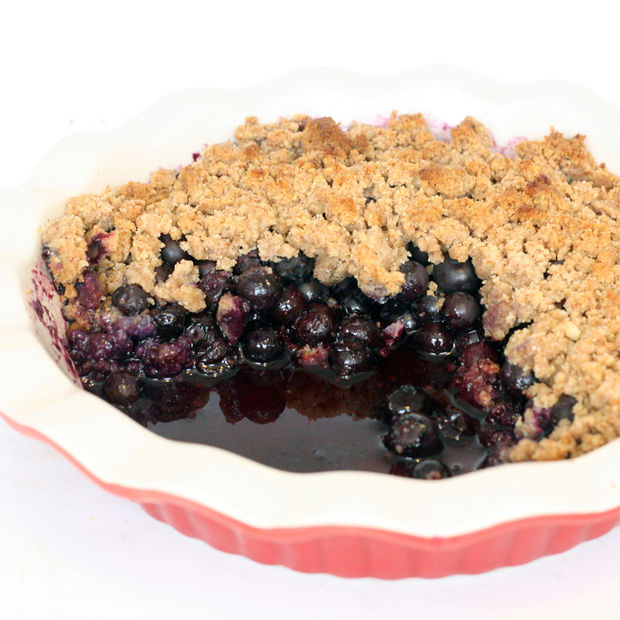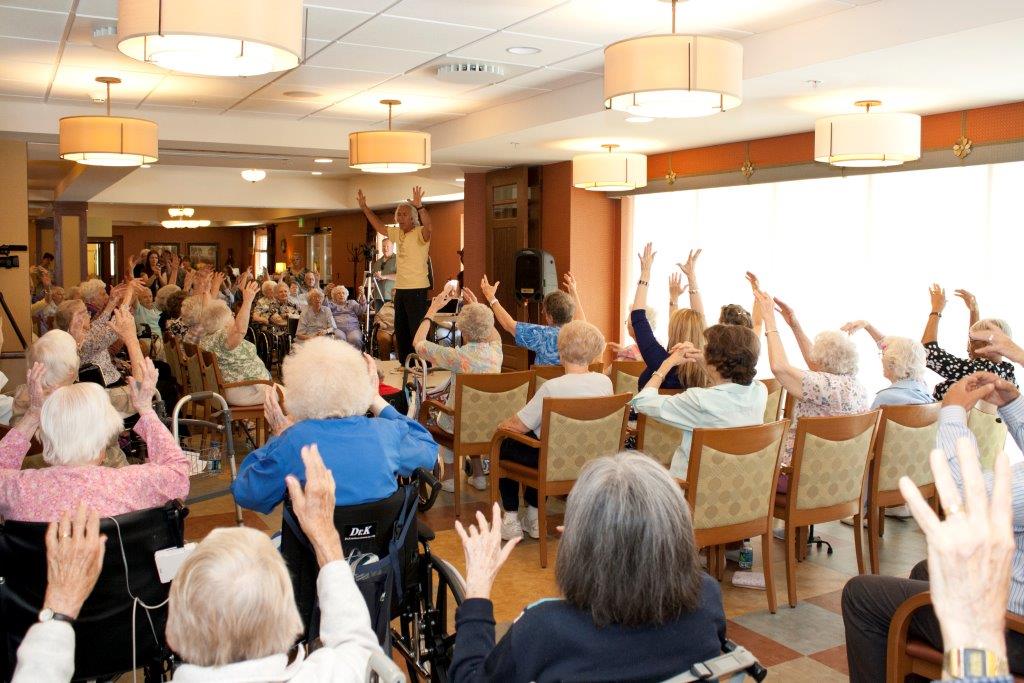Posts Tagged ‘caregiving’
Stamping out Alzheimer’s
For twelve years Lynda Everman was a silent caregiver. Her husband, Richard, was diagnosed with Mild Cognitive 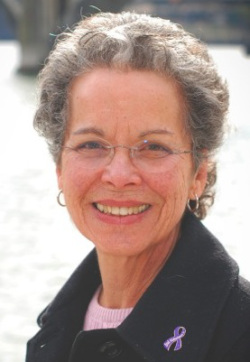 Impairment in 1997; in an effort to preserve his dignity, she told few people what they were going through.
Impairment in 1997; in an effort to preserve his dignity, she told few people what they were going through.
“We were both introverts and private people,” Lynda says. “My husband and I were a team, taking care of each other, moving through a situation that was too painful to address in public.”
After she had to move her beloved husband into assisted living, she went on her first advocacy trip to her state capital, Nashville, where she began telling their story. Along with activist Kathy Siggins, Lynda campaigned for a semipostal stamp that could raise money for Alzheimer’s Disease research.
The proposed stamp is similar to the Breast Cancer semipostal: consumers pay a little extra for the stamp and the additional funds go to the NIH for medical research. The US Postal Service has raised more than 81 million dollars for breast cancer through sales of that stamp. Lynda and Kathy wanted the same opportunity for Alzheimer’s research.
Lynda has been a tireless advocate for fighting Alzheimer’s. On her advocacy site, Help Stamp OUT Alzheimer’s, she shares research and legislative updates, caregiving tips, the work of fellow advocates, and words of encouragement. She is a founding member of three national networks, all under the umbrella of USAgainstAlzheimer’s: ActivistsAgainstAlzheimer’s, ClergyAgainstAlzheimer’s, and WomenAgainstAlzheimer’s and a Board Member of Beating Alzheimer’s By Embracing Science. Together they campaign for policy change and for increased funding for Alzheimer’s research.
Lynda has written to every member of Congress urging them to cosponsor the Semipostal and she and Kathy have made countless visits to members.
Lynda and Kathy visited more than 60 members of Congress, trying to persuade them to sponsor and approve the Alzheimer’s semipostal. Both the House and Senate have to give their “stamp” of approval before the Congressional Budget Office can consider the project.
The bill was introduced in the House as part of the Alzheimer’s Action Now initiative and has 63 cosponsors. Sen. Mikulski will reintroduce a companion bill in the Senate very soon. But if the bill doesn’t pass by the end of the year, it expires.
Here’s where you come in. The stamp requires no governmental funding or increase in taxes. It’s bi-partisan and bi-cameral. You can help RIGHT NOW by calling your congresspersons and asking them to cosponsor H.R. 3092.
“It is important to share your story and speak out for those who cannot,” Lynda says. “ Please help them and their caregivers—and help us make this fundraising stamp a reality.”
Ask that the Postmaster General use her authority to issue an Alzheimer’s Disease Research Semipostal independent of the legislative process. Simply go to: : https://www.uspsoig.gov/blog/putting-stamp-good-causes
To call the U.S. Capitol Switchboard, dial 202-224-3121 and ask to be put through to the offices of your two Senators and Representative. If you don’t know the names of your representatives, you can get that information, as well as the direct line to their offices, by visiting: http://www.contactingthecongress.org.
For more about Lynda’s work, please visit:
www.clergyagainstalzheimers.org and http://alzbabes.org/
In addition to founding ClergyAgainstAlzheimer’s, Lynda served as a editor for “Seasons of Caring: Meditations for Alzheimer’s and Dementia Caregivers” and their recently released Leaders Guide for support groups. She has a blog post on UsA2: http://www.usagainstalzheimers.org/blog/its-time-alzheimers-stamp
For more about the semi postal, please visit www.alzjourney.com/2014/02/15/help-stamp-out-alzheimers/
Deborah Shouse is the author of Love in the Land of Dementia: Finding Hope in the Caregiver’s Journey.
COMING SOON: CONNECTING IN THE LAND OF DEMENTIA: CREATIVE ACTIVITIES TO EXPLORE TOGETHER
An Insider’s Tips for Finding Joy in the Journey
“Alzheimer’s can be a grind,” a caregiver recently told me.
That’s one reason I am constantly seeking those who see the creativity and potential in the journey. I look for inspiration and I found plenty in “Finding Joy in Alzheimer’s: New Hope for Caregivers,” a book by Marie Marley, PhD, and Daniel C. Potts, MD, FAAN. Both have a powerful personal story that they weave into the book, along with practical tips for care partners.
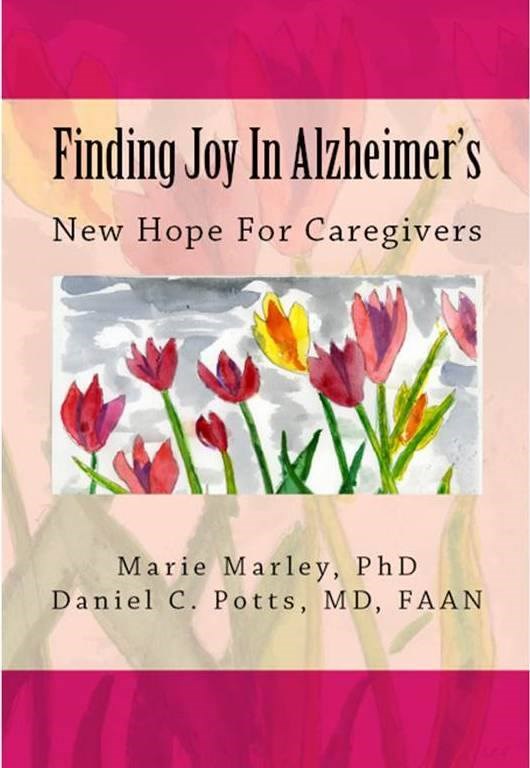 Three Ways to Encourage Your Own Love and Acceptance
Three Ways to Encourage Your Own Love and Acceptance
Here are a few excerpts from Daniel:
- Each interaction we have with another person presents an opportunity to share the hope that is within us.
- As care partners, we must identify and embrace the love present within each individual and we must enable the expression of that love, for personhood to be preserved and dignity promoted. We must also be fully cognizant of the love within ourselves.
- To come to terms with Alzheimer’s you must first let go of the expectation that you’ll find the previous person and instead embrace the new person– just as he is in the present. Since that person will continue changing as time goes by, one must constantly let go of the old person and accept the new one.
Three Ways to Improve Your Time Together
Marie offers these tips for staying connected:
- Use welcoming body language. Don’t sit with your arms crossed; sit with your palms turned upward. This posture says, “I’m receptive to you.”
- Speak slowly and in short, direct sentences, with only one idea to (in) each sentence.
- Laugh a lot. Arrive for your visit with a supply of simple jokes and funny stories.
For more information about Finding Joy in Alzheimer’s, visit ComeBackEarlyToday.com
Deborah Shouse is the author of Love in the Land of Dementia: Finding Hope in the Caregiver’s Journey.
Stirring Up Connections through Cooking
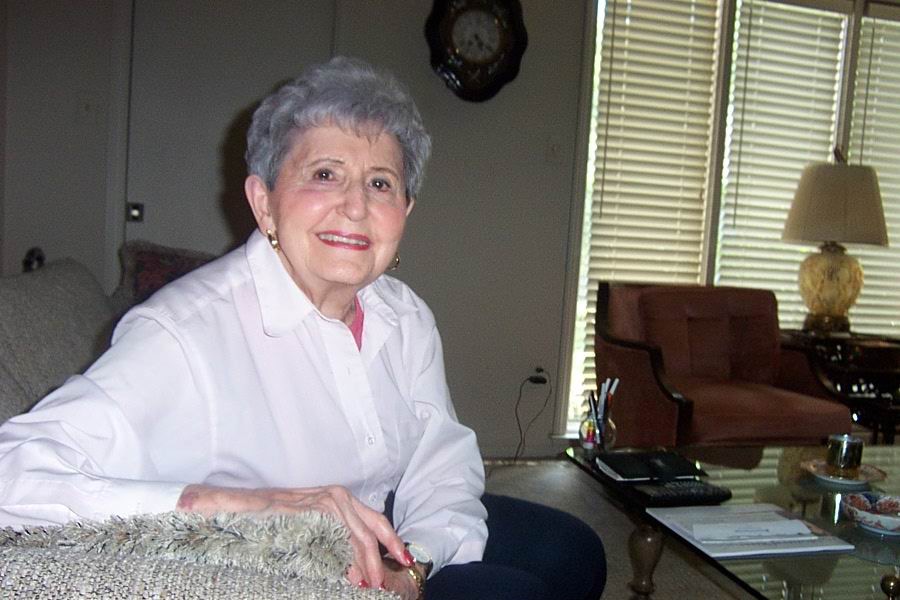 Ron’s mom Mollie was the queen of cooking. Up until age 90, she’d stir up a batch of rice pilaf, use her special grinder to make pink applesauce, or bake her formidable brownies. When she could no longer remember her favorite dishes, we invited her into the kitchen and used her well-worn recipe cards. We chose a time of day when Mollie felt alert and we created a quiet atmosphere, free from extraneous noise and distractions. Since Mollie had trouble standing, we laid our cooking equipment and ingredients on a table, so she could comfortably participate. Then we shared the tasks of measuring, pouring, adding ingredients, stirring, and tasting. We loved this gentle and conversational time in the kitchen. Now Jacqueline Hatch, from Seniorly.com, offers some brain boosting desserts and easy ideas for connecting through the culinary arts.
Ron’s mom Mollie was the queen of cooking. Up until age 90, she’d stir up a batch of rice pilaf, use her special grinder to make pink applesauce, or bake her formidable brownies. When she could no longer remember her favorite dishes, we invited her into the kitchen and used her well-worn recipe cards. We chose a time of day when Mollie felt alert and we created a quiet atmosphere, free from extraneous noise and distractions. Since Mollie had trouble standing, we laid our cooking equipment and ingredients on a table, so she could comfortably participate. Then we shared the tasks of measuring, pouring, adding ingredients, stirring, and tasting. We loved this gentle and conversational time in the kitchen. Now Jacqueline Hatch, from Seniorly.com, offers some brain boosting desserts and easy ideas for connecting through the culinary arts.
Brain Healthy Recipes for the Creative Care Partner
By Jacqueline Hatch
Cooking is a wonderful way to engage the senses and enjoy a meaningful activity with a loved one or client who is living with dementia. According to experts at Alzheimers.net, “Sensory stimulation uses everyday objects to arouse one or more of the five senses (sight, smell, hearing, taste, and touch), with the goal of evoking positive feelings.” Below are some recipes that are simple and fun to make together. These healthy eats provide stimulation for all five senses and are packed with nutrients the brain craves as we age.
Researchers at Scripps Memorial Hospital in California say, “Blueberries help protect the brain from oxidative stress and may reduce the effects of age-related conditions such as Alzheimer’s disease or dementia.” Studies also show that regular consumption of these powerful berries can improve learning skills in aging minds.
- Preheat your oven to 375 degrees.
- Have your loved one help you wash and de-stem 2 pints of blueberries. Together, you can arrange them evenly at the bottom of a 9×9 baking dish. Have her squeeze juice from half a lemon over the top of the berries.
- Together, take a large mixing bowl and combine 1 cup of flour, ¼ cup walnuts, ¼ cup coconut oil, 2 tbsp maple syrup, ¼ tsp cinnamon, and 2 pinches of salt. Invite your loved one to squeeze the other half of the lemon into this mixture and stir until well combined.
- Working as a team, spread this topping mixture over the blueberries, and bake about 30-40 minutes or until the topping is golden.
- Let cool a bit and then enjoy your treat!
Raw Walnut Fudge
The ingredients in this mouth-watering recipe contain tons of nutrients that your brain will love. The coconut oil is rich in antioxidants, the cacao powder contains 4 different neurotransmitters that act as natural anti-depressants, the maple syrup contains manganese and zinc, and the walnuts are rich in omega-3 fatty acids and vitamin E.
- Together, combine 1 cup coconut oil (melted), ¼ cup raw cacao powder, ¼ cup maple syrup, ¼ cup almond butter, ¼ cup organic walnuts (chopped), and 1 tsp vanilla bean powder. Ask your loved one to mix all of these ingredients together with a large spoon.
- Help your loved one spread the mixture evenly in a 5×9 glass pan.
- Put it in the freezer for 30 minutes or until fully hardened.
- Cut and serve!
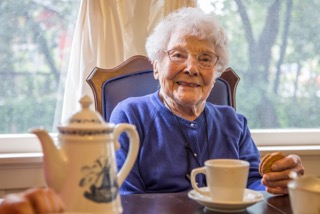 With these easy, healthy recipes on hand, you can get a head start on taking care of your aging brain. Chances are, with the right nutrients in your body, you will even feel happier and more active than ever.
With these easy, healthy recipes on hand, you can get a head start on taking care of your aging brain. Chances are, with the right nutrients in your body, you will even feel happier and more active than ever.
~
Jacqueline Hatch is a writer, editor, and publisher at Seniorly.com, a company that provides support for caregivers and their families during a difficult transition period in their lives. The website provides comprehensive information on aging options, resource articles for healthy living, and a Senior Living Blog.
Sources:
http://www.alzheimers.net/2014-01-23/sensory-stimulation-alzheimers-patients/
http://www.brainhq.com/brain-resources/brain-healthy-foods-nutrition/brain-healthy-recipes
http://www.eatingwell.com/recipes_menus/collections/healthy_mind_and_memory
http://bebrainfit.com/brain-food-recipes/
Deborah Shouse is the author of Love in the Land of Dementia: Finding Hope in the Caregiver’s Journey. Coming soon: Connecting in the Land of Dementia: Creative Activities to Explore Together
Strengthen your Heart, Open Your Ears, and Ignite your Spirit with Conductorcise
Maestro David Dworkin moves his baton and a Strauss waltz begins. But instead of facing a sea of symphonic musicians, the auditorium is filled with people also holding batons, following the Maestro’s movements. They are engaged in the Maestro’s globally renowned exercise program, Conductorcise.
Click here for an exhilarating example: Conductorcise
As the music continues, two women begin to waltz in the aisle. Later, he learns that these women are living with dementia. “They haven’t moved in months,” a health care worker tells him.
At a memory care unit, he passes out batons, handing them even to people who seem slumped and unresponsive. He introduces John Phillip Sousa, offering a few tidbits about the composer. Then he starts a Sousa march and leads his group in vibrant upper body movements. Soon everyone, even three people who seemed oblivious, are conducting along with him.
Such is the power of movement and music.
Leading with Benefits
“The vibrations and energy of the music speak to people,” says Masetro Dworkin. “You benefit from relieving stress, building aerobic stamina, improving listening skills, and increasing social engagement while imagining yourself leading a symphony orchestra.”
As a bonus, you can learn a little about the lives and works of the great composers.
The program appeals to all ages and abilities and has spread around the world, from Holland to Canada to Singapore.
Conducting for Two or More
The program works wonderfully one-on-one.
“You can’t do anything wrong,” Maestro says. “You don’t even need a baton. You can use chopsticks, unsharpened pencils, a straw, or just your arms.”
Here are a few tips for enjoying Conductorcise:
- To get started, you might say, “How about helping me conduct this tune?”
- Select a familiar song your partner enjoys, one that might also inspire conversation and singing.
- Move your arms and upper body to the music and encourage your partner to move as she wishes. Move your lower body as well, if appropriate.
- For those who need extra support, add eye contact and gently stroke their arms.
- Invite friends and family members to join you.
“Everyone wants to be a conductor!” Maestro Dworkin says.
###
Visit http://www.conductorcise.com glean ideas from Maestro’s listening library and information about his training and certification programs.
Julliard-trained Maestro David Dworkin has led orchestras across the globe, and performed as clarinetist with ensembles internationally. He served as conductor and Artistic Consultant for three PBS Television documentaries in the series Grow Old With Me, and devoted much of his career to working with young people. In his 80’s, he has become a sought-after role model for all, demonstrating how exercise, music, joy and a positive outlook can create a healthy journey through life.
Deborah Shouse is the author of Love in the Land of Dementia: Finding Hope in the Caregiver’s Journey.
The Secret of Art-Power: Imagination Rules
This is a story celebrating the arts and creativity, an excerpt from my book Love in the Land of Dementia: Finding Hope in the Caregiver’s Journey.
We are delighted to be presenting a program in partnership with the Liberty Library Art Gallery, the Liberty Arts Commission, and the Heart of America Chapter of the Alzheimer’s Association. If you’re in our area, please feel join us.
The Hills Are Alive
I miss my mom and decide to attend a Memories in the Making art class, designed for people who are living with dementia. I want to meet some of the artists and feel my connection to Mom, who was an avid painter in her earlier years, through the artistic process. Still, I feel nervous as I walk through the nursing home and into a small activity area.
“We have a visitor today,” Harriet, the facilitator, tells the assembled group.
Everyone looks up.
“Come paint with us,” a woman says.
I smile and begin to relax. Harriet hands me bowl of water, paper, brush and watercolors and finds me a place. Then she introduces me to the artists.
Ed, a former veterinarian, has a photograph of a great blue heron in front him. He is a slight, spry man who looks like he could fix any emergency.
“That bird is really coming along,” Harriet tells Ed. Using colored pencils, he has sketched the upper half of the heron. The bird has an inquisitive look. Now Ed is concentrating on drawing an assortment of cattails, reeds, and other marsh plants in the background.
“Ed is married to Rhea,” Harriet tells me, as I look at the splash of free-form color on Rhea’s page. Rhea, who also has Alzheimer’s, is creating a sunset with vivid oranges and purples. I smile at the difference in their art—Ed’s controlled sense of detail, Rhea’s spontaneous bursts of color. I imagine those traits made for a good partnership.
“We’ve been together twenty-two years,” Rhea says. She has a plump welcoming look about her. “Or maybe it’s twenty-five years. Do you remember?” she asks Ed.
“A long time,” Ed says.
Norman has beautiful silver hair, deep brown eyes, and is dressed in a Polo shirt and slacks. He looks like he could easily be running a meeting or entertaining important clients on the golf course. Formerly an engineer, he was living in New Orleans, Harriet explains, and was moved up here to be near family. He is recreating a mountain lake scene and has quickly captured the essence of his photograph.
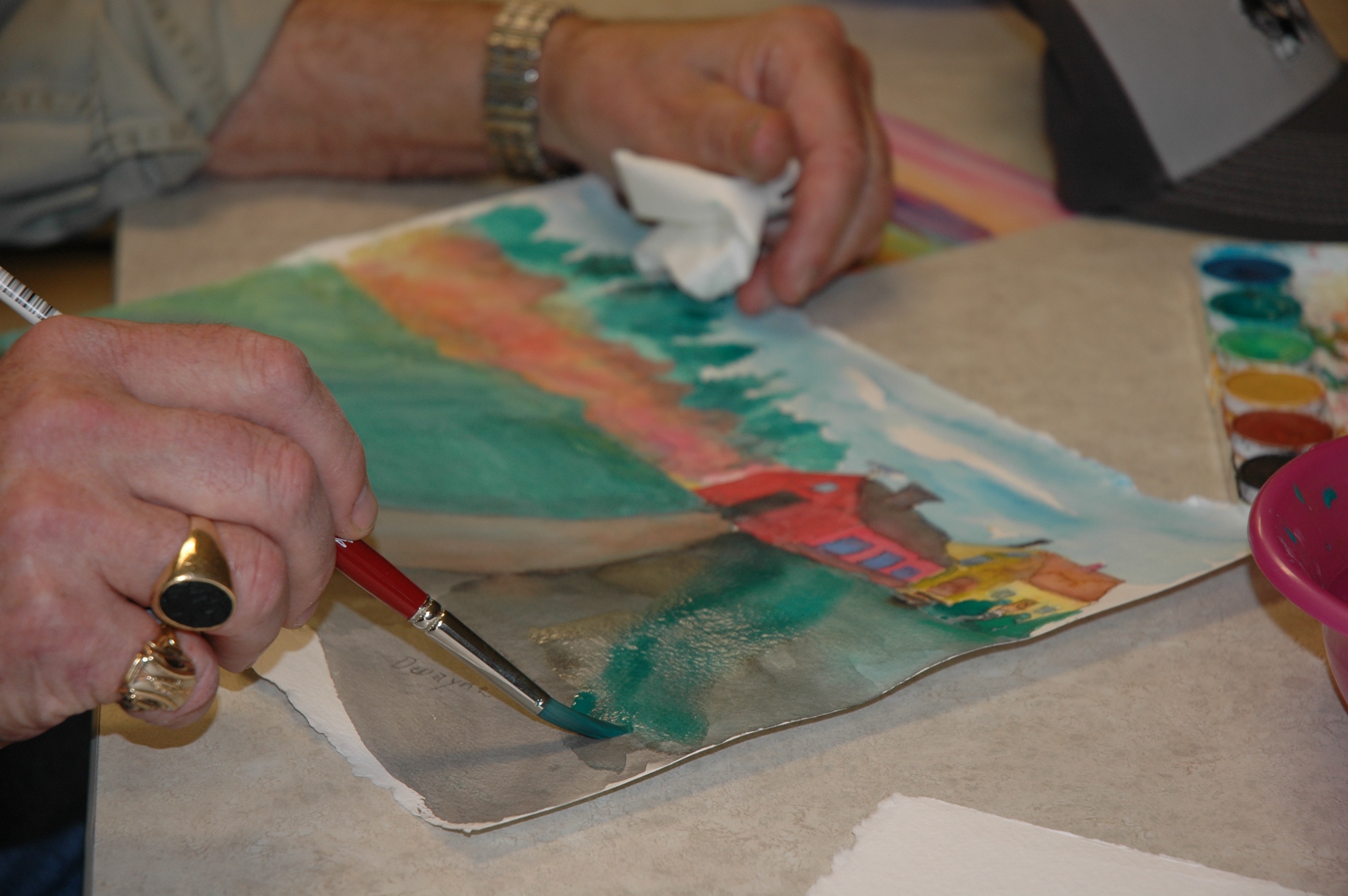 “I just use my fingers to gauge the perspective,” he tells me, when I compliment his work. In his spare time, Harriet says, he is recreating maps of area bridges.
“I just use my fingers to gauge the perspective,” he tells me, when I compliment his work. In his spare time, Harriet says, he is recreating maps of area bridges.
As I sit down to my own paper and watercolors, I hear someone from the room next-door singing, The Sound of Music.
Harriet sings along and we chime in. As I paint, I feel a sense of connection. Harriet knows how to create a space where the artist can blossom.
Harriet starts a verse of Over There and everyone joins in.
After some time, Harriet says, “It’s almost time to stop for today.” I take a final walk around the table. Ed’s heron looks ready to enter an Audubon competition. Rhea’s sunset is colorful and dramatic. Norman’s hills look complete and his lake is taking shape. My own painting looks plain and unsophisticated next to the rest of the art.
“Have any of these people had art lessons before?” I ask, as I help Harriet empty water bowls and clear away used paper towels.
“No,” she tells me.
For most of these artists, this is a tender and uncertain time, a period when memory and rational thinking are often  blotchy and blurred, where words can fall away as quickly as autumn leaves. This art program gives them a chance to express themselves freely and creatively. Out of the mental chaos and confusion, the art emerges, vibrant, true, and exciting.
blotchy and blurred, where words can fall away as quickly as autumn leaves. This art program gives them a chance to express themselves freely and creatively. Out of the mental chaos and confusion, the art emerges, vibrant, true, and exciting.
As I am taking leave of Harriet, Norman comes back into the room.
“Is there white?” he says. “I’m going to need white for the snow on the mountain tops.”
“I’ll have some for next time,” Harriet promised. “Meanwhile, would you like one of these white pencils?”
Norman takes the pencil. “The snow makes all the difference,” he tells me. His walk is steady and sure and he leaves the room humming, “The hills are alive.”
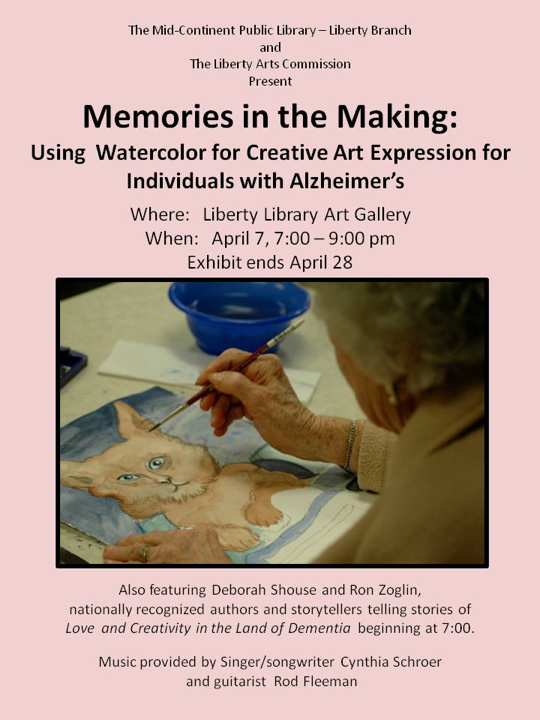 Deborah Shouse is the author of Love in the Land of Dementia: Finding Hope in the Caregiver’s Journey.
Deborah Shouse is the author of Love in the Land of Dementia: Finding Hope in the Caregiver’s Journey.
One Simple Secret that Lights Up Lives
What if someone listened to you carefully enough to remember some of your favorite accomplishments? What if someone reminded you of those treasured moments as a way of celebrating you?
“When people can’t tell their own stories, their care partners can tell the stories for them,” says Tryn Rose Seley, expressive arts facilitator and author of 15 Minutes of Fame. “You can support significant events with affirmation cards, stating the achievement and thanking them.”
For example, for a client who is a retired teacher, Tryn prints on index cards, “You love children so much. You have taught many kindergarteners, and made a wonderful difference in their lives. Thank you.”
She puts these cards in prominent locations, so they can talk about them during the day.
When I interviewed Tryn for my upcoming book, I fell in love with this simple yet profound idea. I thought of my mother and the kinds of cards I could have created for her: “You served your country as a nurse in WWII. Thank you so much for that act of bravery.” “You painted wonderful pictures that you shared with family and friends. Thank you.”
I thought of friends who are living with dementia and the affirmations they would enjoy. I also thought of myself and my beloved partner Ron and the kinds of stories and affirmations that would make us glow.
Tryn reminded me how important meaningful activities, loving support, and affirmations are for people who are living with dementia, for their care partners, and for all of us.
***
Tryn Rose Seley is a musician, photographer, author, and expressive arts facilitator. She loves to interact with people of every age and does so on a regular basis. She leads musical experiences, shares her caregiver book, and writes every day, sometimes on the back of grocery receipts, other times on the world-wide-web. www.caregiverheart.com
Deborah Shouse is the author of Love in the Land of Dementia: Finding Hope in the Caregiver’s Journey.
Learning about Love through the Dementia Journey
This month, I’ve been asking myself and others, What have you learned about love from your dementia journey? Here are some of the profound answers:
I learned that it is redefined. I loved my mother as my parent, and then learned to love her as a child. And I would not trade that experience for anything. Pamela J. Van Ahn, Executive Director at Caring Together in Hope, Inc., Atlanta, GA
I have learned that love remains, even as memory fails. Long after your name is forgotten, there are still frequent glimpses of recognition that are very meaningful. The Alzheimer’s patient does not become “a different person”. They are much more “still there” than easily meets the eye. With Alzheimer’s disease, things that have emotional context are remembered the longest, and love is a strong emotion. Max Wallack, research intern in the Molecular Psychiatry in Aging Laboratory at Boston University School of Medicine, Boston MA.
I have learned so many lessons regarding love through my mothers journey with dementia. Here are just a couple of them. There are multiple levels of unconditional love. Each one is more precious and runs deeper then the next. “Letting Go” of our need to control is one of the most loving things we can do for a person with dementia and ourselves. Allowing a person with dementia to be in a loving respectful relationship, even if it might be with someone unexpected, is a gift to all and does not mean they love us less. Love runs much deeper than a name. We need to stop quizzing a person with dementia to check if they know and love us. A name has nothing to do with the bond and connection between two souls. Lori La Bey, Founder of Alzheimer’s Speaks , St. Paul, Minnesota, www.AlzheimersSpeaks.com
Deborah is the author of Love in the Land of Dementia: Finding Hope in the Caregiver’s Journey.
Appreciating the Power of Love
“How long have you been together?” the younger couple asked Ron and me.
“Twenty-two years,” we answered.
“Wow!” they said. They’d been in love for seven months and our decades-long romance must have seemed exotic and slightly unbelievable.
“What are the secrets of a good relationship?” they asked. “Please share your wisdom.”
First, Ron and I basked in the idea that two people believed we possessed actual wisdom! Then we shared our insights.
How We Learned about Love
Our insights came from growing as individuals and as a couple during our wonderful long relationship and from earlier relationships that had helped us become our true selves. We also learned from watching our parents maintain their relationships in the face of dementia.
When Ron’s father Frank was in a memory care unit, Ron’s mom Mollie told her husband, “I love you so much.” Frank replied, “Not as much as I love you!.” Those were some of Frank’s last words and that sentence stayed with Mollie through and beyond her grieving.
During my growing up years, my father was circumspect in declaring his love for Mom. But when she slipped into dementia, Dad showed me what a true romantic he was. He treated her like he was courting her; he showered Mom with compliments and kisses and frequently he expressed his love for her. Even when she could no longer talk, she still enjoyed her favorite foods—he faithfully fed her sliced strawberries and chocolate candies.
Love Me Tender, Make Me Laugh, Always Have My Back
My parents were my role models and I also learn an enormous amount from the couples I interview every week for the love story column I write for the Kansas City Star Magazine. Here are some of the qualities people most love about their life partners and spouses.
Loves me just as I am
Takes care of me/Always has my back
Makes me laugh
Shares my values/ Complements me
Works hard/ Is honest and reliable
Always puts other people first/ Always puts me first
Inspires me to be better/ Appreciates me
Love Lights the Way
Some months ago, Oprah had author, visionary and cultural mid-wife Jean Houston on her TV show. “What do you wish people knew?” Oprah asked Jean.
“I wish people knew how powerful love is,” Jean answered.
That was one of the grandest lessons from my journey with my mom through her dementia: the power of love. Her love lasted all her life, far beyond her memory of things and people. Her love was a spark that lit up her life and mine.
An Insider’s Tips for Evoking Imagination
Molly Middleton Meyer pulls a red silk scarf out of her rolling suitcase and asks the group of 15, “What does this scarf have to do with springtime?”
A brief silence unfolds while people consider.
“I used to wrap a scarf around my head in the convertible,” one woman says.
The woman sitting next to her smiles. “Scarves blow in the wind,” she says.
Molly mimics the scarf wafting in a breeze.
“If the scarf was music, what kind of music would it be?” Molly asks.
“Jazz,” a man says.
“Rock and roll.”
“Classical.”
Molly, who has an MFA and is the creator of Mind’s Eye Poetry in Dallas, Texas, reaches into her suitcase and brings out a small watering can. She continues the relaxed pacing, asking for impressions, invoking imagination, creating a sense of comfort and connection for this group of people who live in a memory care facility.
After 20 minutes of creative play, Molly takes out a slim book and says, “Here’s a poem about spring that I really like. See what you think.”
She reads the short, rhyming verse and asks for reactions. She then invites the group to contribute to a writing project.
“There are no wrong answers,” she assures them. “I’ll ask something and you’ll say the first thing that comes into your mind. For example, when I say ‘springtime’ what flowers do you think of? ”
“Daffodil, tulip, roses…” the group offers.
Molly writes down each flower and reads it back to the group.
“We have our first line of poetry,” she tells them.
“Imagine where the flowers are, in a vase, in the garden?”
“What colors are they? What time of day is it?”
Every question invites imagination and word-by-word, the poem emerges. After they’ve created three short poems, Molly shows them a piece of art and asks, “What do you see?” She captures their observations and uses their words to create a poem.
Here’s an example of a poem segment created after looking at Oriental Poppies, Georgia O’Keefe’s painting of two large orange poppies.
I see two evening gowns
on a diagonal, flowing.
I see a Scottie dog
prancing in a field of orange.
I see summertime in Santa Fe.
I see a black bird soaring into sunset.
“When I read back their words and say, ‘You all just wrote this,’ it’s very empowering,” Molly says.
For those at home who want to have a session of creative imagining, Molly has these suggestions:
Gather a few interesting objects, such as a recipe book, a nature photo, a pot holder, and one at a time, show them to your partner and ask, “Mom, what do you think about when you see this recipe book?” Give her plenty of time to respond and jot down her answers. If she asks, “Why are you writing?” tell her, “I value what you have to say.”
Soon, you’ll have a collection of words and phrases. You can take a photo of the object along with the poem it inspired and put them together in a book. #
Molly Middleton Meyer is the founder of Dallas-based, Mind’s Eye Poetry. To date, she has facilitated over 600 poems written by people with dementia. Mind’s Eye Poetry has been featured in U.S. News and World Report, the Huffington Post, the Dallas Morning News, Affect Magazine, Growing Bolder Magazine, and on NPR. When Middleton Meyer is not facilitating poetry, she writes her own. Her first book of poetry, Echo of Bones was published in 2014. For more information, contact Molly Middleton Meyer, M.F.A. Poetry Facilitator/Speaker at www.mindseyepoetry.com
Deborah Shouse is the author of Love in the Land of Dementia: Finding Hope in the Caregiver’s Journey.
The Scent of Creativity: Three Reasons to Add Aromas into Your Life
Madeline could barely sleep at night. She was worried her husband would wake up confused and wander off, so she kept her hand on his chest all night. Her grown children, concerned about her exhaustion, called Jayne Clairmont, owner of English Rose Suites, a dementia consulting and home care business. Jayne listened sympathetically to Madeline’s story and offered a simple solution.
“Place a few drops of pure lavender oil in his navel or on the bottom of his feet before bed,” she advised.
Jayne has shared the powers of essential oils in her national speaking and consulting. She collaborated with Health Partners on a study of 26 memory care residents. The study showed that lavender drops, administered externally before bed, added 43 extra minutes to the sleep cycle. Some sleeping pills only provide an additional 13 minutes of sleep.
For Jayne, understanding essential oils is a simple way to deepen comfort and connection. She starts by learning more about the person living with dementia, so she best knows how to support him. She listens for issues, such as restless sleep, anxiety, or exhaustion. Then she offers a few easy aromatherapy solutions.
“Lavender also induces calm,” Jayne says. She recommends lavender essence for foot massages. When people are pacing and anxious, Jayne suggests a few drops of soothing lavender on a silk flower that they can hold and sniff or wear as a boutonniere.
For someone who’s struggling to stay alert, a few drops of peppermint applied with a warm cloth may help. Jayne may add drops of peppermint to water and use a diffuser or spray bottle to mist the air.
Citrus scents, such as orange and lemon, enhance appetite and help people wake up.
“Essential oils benefit both the care partner and the person living with dementia,” Jayne says. “Keep it simple. Don’t use too many oils and don’t use too much of any oil.”
Deborah Shouse is the author of Love in the Land of Dementia: Finding Hope in the Caregiver’s Journey.

